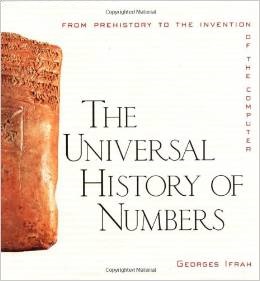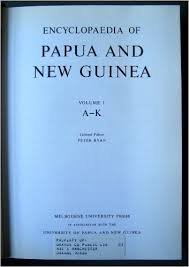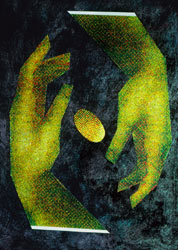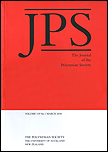Other bases
No base: not all languages have numeral systems. For instance, many languages of Melanesia have (or once had) counting systems based on parts of the body which do not have a numeric base; there are (or were) no numerals, but rather nouns for relevant parts of the body—or simply pointing to the relevant spots—were used for quantities. For example, 1–4 may be the fingers, 5 'thumb', 6 'wrist', 7 'elbow', 8 'shoulder', etc., across the body and down the other arm, so that the opposite pinkie represents a number between 17 (Torres Islands) to 23 (Eleman). For numbers beyond this, the torso, legs and toes may be used, or one might count back up the other arm and back down the first, depending on the people.
3 (ternary or trinary): it is the base-3 numeral system. Analogous to a bit, a ternary digit is a trit (trinary digit). One trit contains log2(3) (about 1.58496) bits of information.
A base-three system is used in Islam to keep track of counting Tasbih to 99 or to 100 on a single hand for counting prayers (as alternative for the Misbaha).
The adjective “ternary” also lends its name to the balanced ternary system, used in comparison logic and ternary computers. For example the Setun (Russian: Сетунь) was a balanced ternary computer developed in 1958 at Moscow State University that used three-valued ternary logic instead of the two-valued binary logic prevalent in other computers (Brousentsov, Maslov, Ramil Alvarez, & Zhogolev, 2015).
4 (quaternary): Quaternary is the base-4 numeral system. It uses the digits 0, 1, 2 and 3 to represent any real number.
Some Austronesian and Melanesian ethnic groups, some Sulawesi and some Papua New Guineans, count with the base number four, using the term asu and aso, the word for dog, as the ubiquitous village dog has four legs (Ryan, 1972). This is argued by anthropologists to be also based on early humans noting the human and animal shared body feature of two arms and two legs as well as its ease in simple arithmetic and counting. The system has a correlation to the dozen counting system and is still in common use in these areas as a natural and easy method of simple arithmetic.
This is argued by anthropologists to be also based on early humans noting the human and animal shared body feature of two arms and two legs as well as its ease in simple arithmetic and counting. The system has a correlation to the dozen counting system and is still in common use in these areas as a natural and easy method of simple arithmetic.
6 (senary): It has six as its base. Like decimal, it is a semiprime, though being the product of the only two consecutive numbers that are both prime (2,3) and it has a high degree of mathematical properties for its size.
Each regular human hand may be said to have six unambiguous positions; a fist, one finger (or thumb) extended, two, three, four and then all five extended. If the right hand is used to represent a unit, and the left to represent the 'sixes', it becomes possible for one person to represent the values from zero to 55senary(35decimal) with their fingers. For example, if three fingers are extended on the left hand and four on the right, 34senary is represented. This is equivalent to 3 × 6 + 4 which is 22decimal. Much better than the usual ten obtained in standard finger counting.
In addition, this method is the least abstract way to count using two hands that reflects the concept of positional notation, as the movement from one position to the next is done by switching from one hand to another (Bloom, 2001).
The Morehead-Maro languages of Southern New Guinea are examples of the rare base 6 system. Kanum is one of these languages.
8 (octal): It has eight as its base. Octal numerals can be made from binary numerals by grouping consecutive binary digits into groups of three (starting from the right).
It is used in the Yuki language of California and in the Pamean languages of Mexico, because the Yuki and Pame keep count by using the four spaces between their fingers rather than the fingers themselves (Ascher, 1994).
Octal became widely used in computing when systems such as the PDP-8, ICL 1900 and IBM mainframes employed 12-bit, 24-bit or 36-bit words. Octal was an ideal abbreviation of binary for these machines because their word size is divisible by three (each octal digit represents three binary digits). So four, eight or twelve digits could concisely display an entire machine word.
12 (duodecimal): It has twelve as its base. The number twelve is the smallest number with four non-trivial factors (2, 3, 4, 6), and the smallest to include as factors all four numbers (1 to 4) within the subitizing range. As a result of this increased factorability of the radix and its divisibility by a wide range of the most elemental numbers (whereas ten has only two non-trivial factors: 2 and 5, with neither 3 nor 4), duodecimal representations fit more easily than decimal ones into many common patterns, as evidenced by the higher regularity observable in the duodecimal multiplication table. As a result, duodecimal has been described as the optimal number system (Dvorsky, 2013).
Historically, units of time in many civilizations are duodecimal. There are twelve signs of the zodiac, twelve months in a year, and the Babylonians had twelve hours in a day (although at some point this was changed to 24).
It is possible to count to 12 with your thumb acting as a pointer, touching each finger bone in turn. A traditional finger counting system still in use in many regions of Asia works in this way, and could help to explain the occurrence of numeral systems based on 12 and 60 besides those based on 10, 20 and 5.
Traditional Chinese calendars, clocks, and compasses are based on the twelve Earthly Branches. There are 12 inches in an imperial foot, 12 ounces in a troy pound, 12 old British pence in a shilling, 24 (12×2) hours in a day, and many other items counted by the dozen, gross (144, square of 12) or great gross (1728, cube of 12). The Romans used a fraction system based on 12, including the uncia which became both the English words ounce and inch. And we could continue with other examples.
24 (quadrovigesimal): It has twenty-four as its base. The solar time includes a base-24 component: there are 24 hours in a day.
Umbu-Ungu, also known as Kakoli, is reported to have base-24 numerals (Gordon, 2005 - Bowers & Lepi, 1975).
32 (duotrigesimal): It has thirty-two as its base. This system could be viewed as a natural extension of the hexadecimal system. Each symbol in the two systems corresponds to a binary number of 5 and 4 digits respectively. This features makes it very simple to transform a number in the present system to the equivalent binary number or to change the latter in the former.
Ngiti - or South Lendu, an ethnolinguistic group located in the Ituri Province of the Democratic Republic of the Congo - is reported to have a base 32 numeral system with base-4 cycles (Hammarström, 2006).
It is very useful in computer programming, encryption, high precision computations and results of high-precision measurements (e.g. in geodesy and astronomy).
60 (sexagesimal): It has sixty as its base. It originated with the ancient Sumerians in the 3rd millennium BC, it was passed down to the ancient Babylonians, and it is still used—in a modified form—for measuring time, angles, and geographic coordinates.
The number 60, a superior highly composite number, has twelve factors, namely {1, 2, 3, 4, 5, 6, 10, 12, 15, 20, 30, 60}, of which 2, 3, and 5 are prime numbers. With so many factors, many fractions involving sexagesimal numbers are simplified.
For example, one hour can be divided evenly into sections of 30 minutes, 20 minutes, 15 minutes, 12 minutes, 10 minutes, 6 minutes, 5 minutes, 4 minutes, 3 minutes, 2 minutes, and 1 minute. 60 is the smallest number that is divisible by every number from 1 to 6; that is, it is the lowest common multiple of 1, 2, 3, 4, 5, and 6.
As stated for the duodecimal system, It is possible for people to count on their fingers to 12 using one hand only (right hand), with the thumb pointing to each finger bone on the four fingers in turn and to display the number of iterations on the other (left hand) until five dozens: with two hands people can easily count until 60.
Ekari, a Trans–New Guinea language spoken by about 100,000 people in the Paniai lakes region of the Indonesian province of Papua, has a base-60 system.
Unlike most other numeral systems, sexagesimal is not used so much in modern times as a means for general computations, or in logic, but rather, it is used in measuring angles, geographic coordinates, and time.
80 (octogesimal): It has eighty as its base. Supyire, or Suppire, is a Senufo language spoken in the Sikasso Region region of southeastern Mali and in adjoining regions of Ivory Coast. The number system of the Supyire people is unique, and quite confusing. Values exist for numbers 1-5, 10, 20, 80, and 400. People count in twenties (with 5 and 10 as subbases) up to 80, then by eighties up to 400, and then by 400s. After ten, a distinct prefix is associated with the teens, twenties, thirties, and so on.
Base 10 has a distinct advantage over larger counting units such as 60, 30, or 20: its magnitude is easily managed by the human mind, since the number of distinct names or symbols that it requires is quite limited, and as a result addition and multiplication tables using base 10 can be learned by rote without too much difficulty.
It is far, far harder to learn the sixty distinct symbols of a base 60 system, even if large numbers can then be written with far fewer symbols!
In addition the multiplication tables require considerable feats of memorisation (sixty tables, each with sixty lines).
At the other extreme, small bases such as 2 and 3 produce very small multiplication and addition tables to learn by heart; but they require very lengthy strings to express even relatively small numbers in speech or writing, a difficulty that base 10 avoids.









